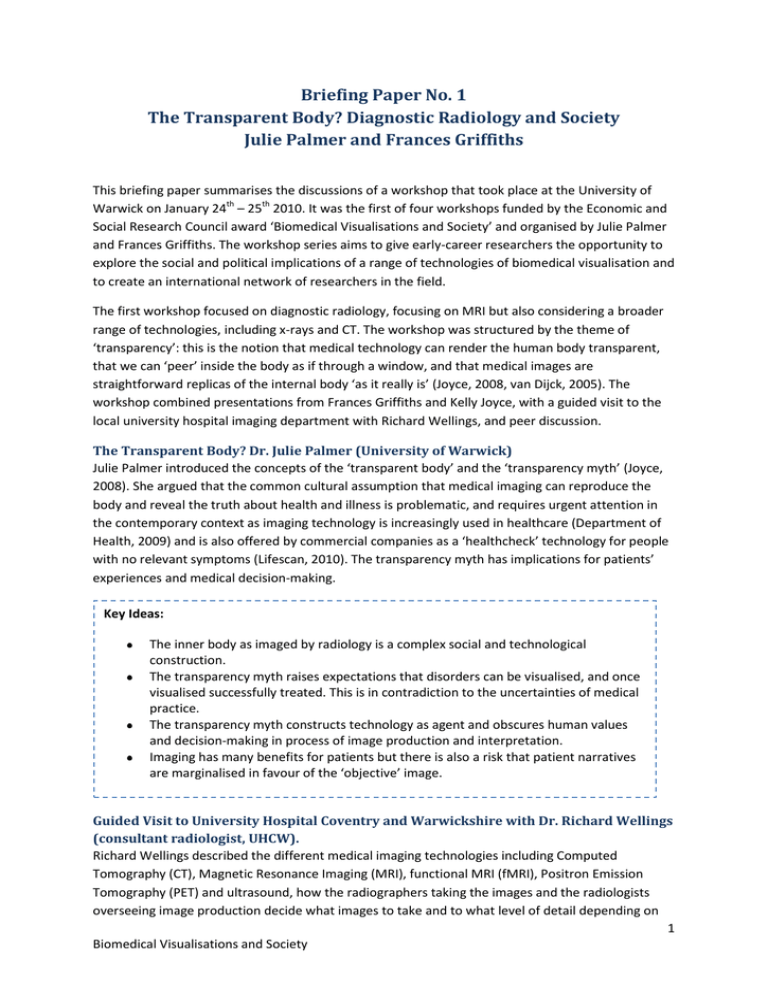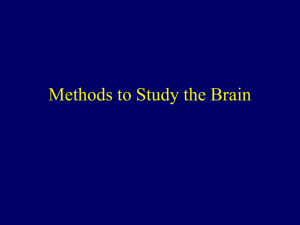Briefing Paper No. 1 The Transparent Body? Diagnostic Radiology and Society
advertisement

Briefing Paper No. 1 The Transparent Body? Diagnostic Radiology and Society Julie Palmer and Frances Griffiths This briefing paper summarises the discussions of a workshop that took place at the University of Warwick on January 24th – 25th 2010. It was the first of four workshops funded by the Economic and Social Research Council award ‘Biomedical Visualisations and Society’ and organised by Julie Palmer and Frances Griffiths. The workshop series aims to give early-career researchers the opportunity to explore the social and political implications of a range of technologies of biomedical visualisation and to create an international network of researchers in the field. The first workshop focused on diagnostic radiology, focusing on MRI but also considering a broader range of technologies, including x-rays and CT. The workshop was structured by the theme of ‘transparency’: this is the notion that medical technology can render the human body transparent, that we can ‘peer’ inside the body as if through a window, and that medical images are straightforward replicas of the internal body ‘as it really is’ (Joyce, 2008, van Dijck, 2005). The workshop combined presentations from Frances Griffiths and Kelly Joyce, with a guided visit to the local university hospital imaging department with Richard Wellings, and peer discussion. The Transparent Body? Dr. Julie Palmer (University of Warwick) Julie Palmer introduced the concepts of the ‘transparent body’ and the ‘transparency myth’ (Joyce, 2008). She argued that the common cultural assumption that medical imaging can reproduce the body and reveal the truth about health and illness is problematic, and requires urgent attention in the contemporary context as imaging technology is increasingly used in healthcare (Department of Health, 2009) and is also offered by commercial companies as a ‘healthcheck’ technology for people with no relevant symptoms (Lifescan, 2010). The transparency myth has implications for patients’ experiences and medical decision-making. Key Ideas: The inner body as imaged by radiology is a complex social and technological construction. The transparency myth raises expectations that disorders can be visualised, and once visualised successfully treated. This is in contradiction to the uncertainties of medical practice. The transparency myth constructs technology as agent and obscures human values and decision-making in process of image production and interpretation. Imaging has many benefits for patients but there is also a risk that patient narratives are marginalised in favour of the ‘objective’ image. Guided Visit to University Hospital Coventry and Warwickshire with Dr. Richard Wellings (consultant radiologist, UHCW). Richard Wellings described the different medical imaging technologies including Computed Tomography (CT), Magnetic Resonance Imaging (MRI), functional MRI (fMRI), Positron Emission Tomography (PET) and ultrasound, how the radiographers taking the images and the radiologists overseeing image production decide what images to take and to what level of detail depending on 1 Biomedical Visualisations and Society the clinical problem and resource constraints. Much of the visit was spent viewing images on a computer screen, seeing and having explained how the computer code produced by the scanners can be used to produce three (3D) and four (4D) dimensional images. For example, a screen image can represent the patient’s heart in 3D with the coronary arteries visible on its surface without the intrusion of the surrounding tissues and a 4D image can show the heart valves as if in action. A screen image can represent the inside of a patient’s skull with its blood vessels, but without the brain, making it easier to see an aneurysm that needs clipping. We were given insight into how radiologists develop ways of seeing medical images such as seeing a series of 2D images as if 3D, noticing all that is there to notice rather than expected visual patterns, and making the most of propensities of the human visual system (for example human visual system is particularly good at seeing vertical forms so radiologists turn chest x-rays sideways to look at the ribs). As the images are basically computer code they are easily stored and transported. Key Ideas: Images are clinically constructed depending on the clinical question Training and expertise changes what is perceived in medical images and might be different from what can be visually demonstrated to non-experts (clinicians and patients) The form of reporting of medical images for clinicians and patients might change (currently text reports are the norm) The uncertainties about how the image relates to the imaged patient are rarely discussed in day to day clinical work but may be made explicit when a difficult clinical decision is being made A Sacred Technology? Connecting Cultural Stories about MRI to Medical Practice. Dr. Kelly Joyce (National Science Foundation & College of William and Mary, VA, USA). Kelly Joyce began by outlining the research that has been done in diagnostic radiology in the disciplines of history, sociology, science and technology studies, English/film studies, and feminist studies and positioning her own research into MRI within this field. Joyce argued that MRI has the status of a ‘sacred technology’ in contemporary US culture, both in popular culture and among clinicians. Joyce described the extensive work of technicians in interpreting and reporting MRI examinations, and explored the policy implications of the sacred status of MRI that obscures this labour. Key Ideas: MRI images are commonly perceived to be equivalent to the body. MRI is talked about as if it acts without human intervention (MRI as agent). MRI is equated with progress. These cultural narratives obscure the knowledge, skill and labour of clinicians and technicians in producing the images, translating the image into reports, and making medical decisions. Policy concerns include: lack of regulation of parameters for MRI exams, health insurance policies that reimburse only one reading of an exam, few regulations about doctors training and interpretation of MRI scans. 2 Biomedical Visualisations and Society Discussion The discussion focused first on the interdisciplinary nature of research in this field, the problems and advantages of multi-disciplinary approaches (particularly for early-career researchers) and the range of research methods employed. Participants explored the language used to talk about medical imaging including spatial metaphors (mapping the body)and words like ‘peeping’ or ‘peering’ that imply the illicitness of looking inside the body. It was noted that the English language contains a lot of expressions that conflate looking with knowing, whereas this is not the case in all languages. Visual culture also varies by national context, as evidenced by Joyce’s fieldwork in Japan. We concluded by collating suggestions for further research in the field. Suggested directions for further research: Further critical attention to the diagnostic context Comparative studies in different national contexts, with different visual cultures and healthcare systems Exploration of the other senses. Imaging is not a purely visual experience for patients. Patient experience of imaging Role of radiologists and radiographers in image production and interpretation Art and visualisation: How are artists playing with or contesting the transparency myth? References Department of Health (2009) Imaging and radiodiagnostic activity, 2008/09 Available online <http://www.dh.gov.uk/en/Publicationsandstatistics/Publications/PublicationsStatistics/DH _103389> (accessed 22 February 2010) Joyce, K. A. (2008) Magnetic Appeal: MRI and the Myth of Transparency, Ithaca, Cornell University Press. Lifescan (2010) Company website. Available online <http://www.lifescanuk.org/> (accessed 7 April 2010) Van Dijck, J. (2005) The Transparent Body: A Cultural Analysis of Medical Imaging, Seattle, WA, University of Washington Press. 3 Biomedical Visualisations and Society






